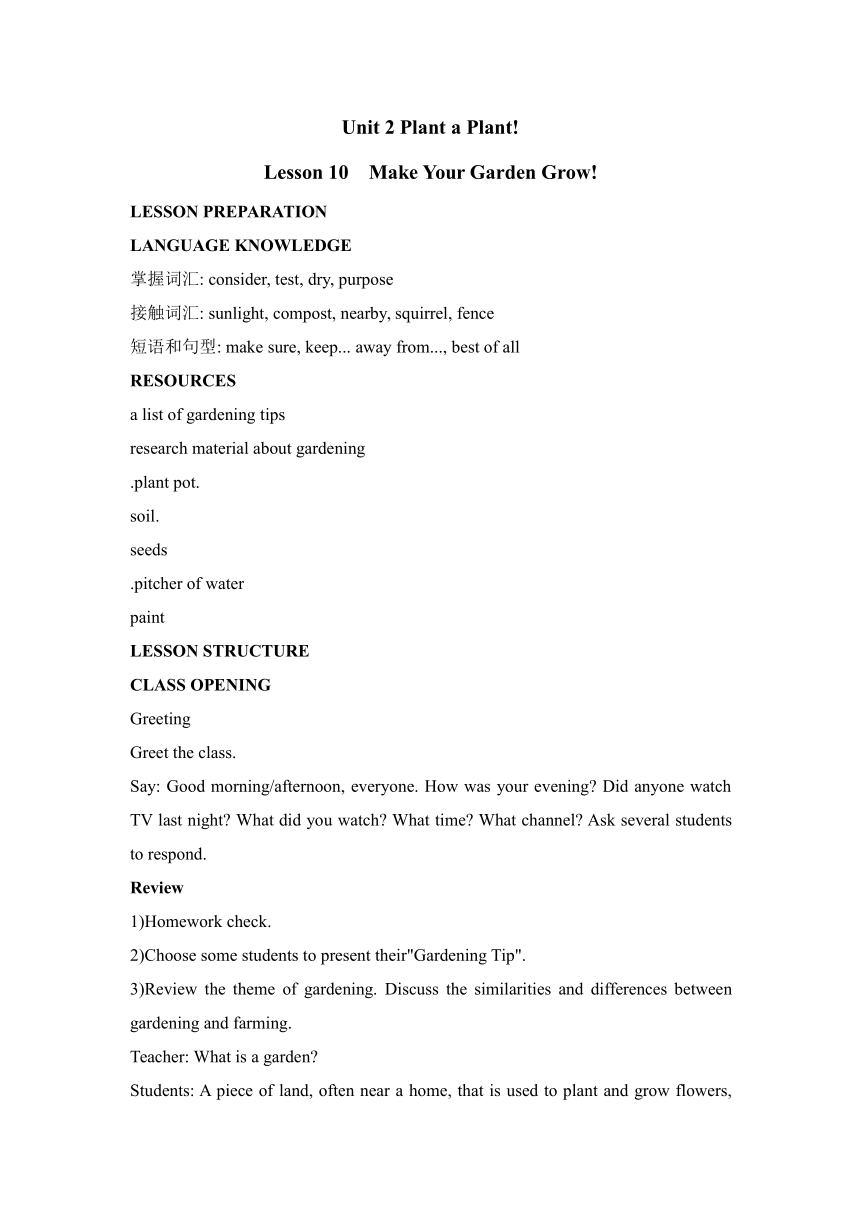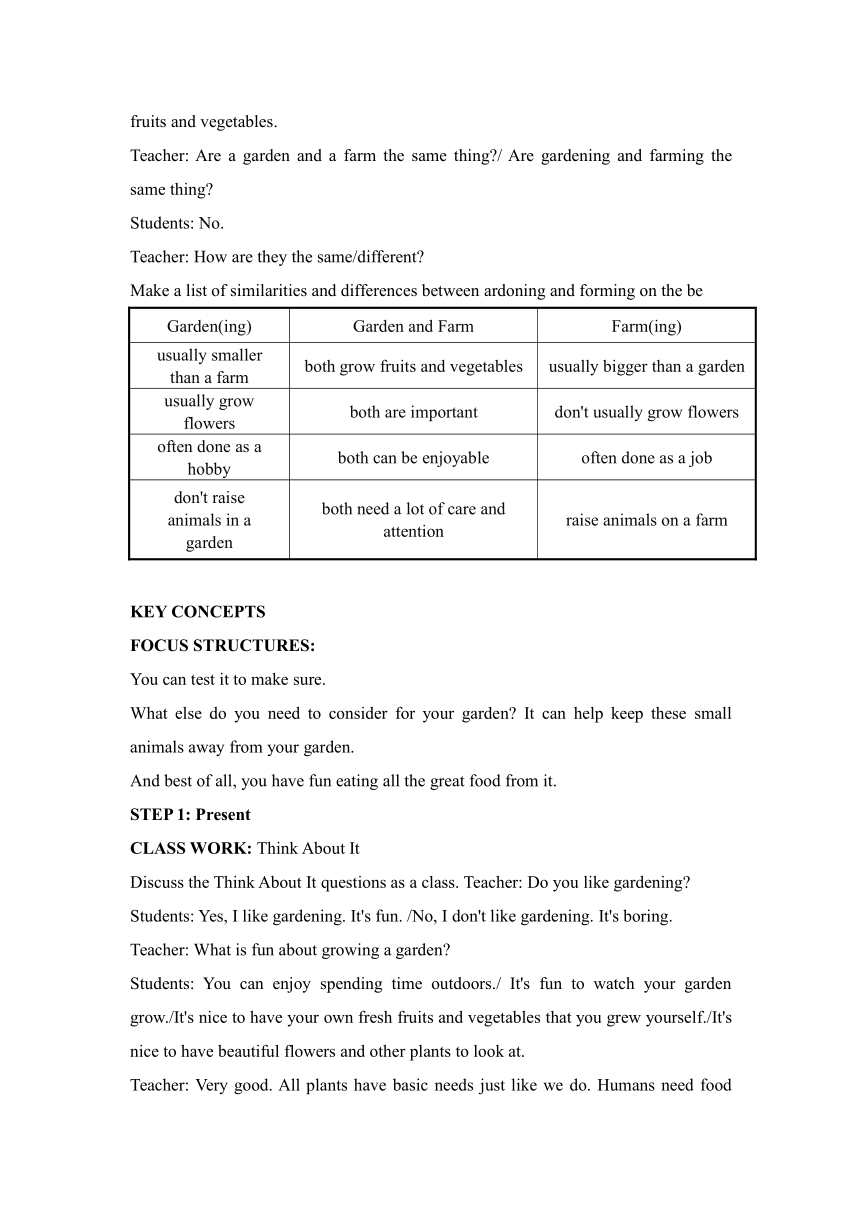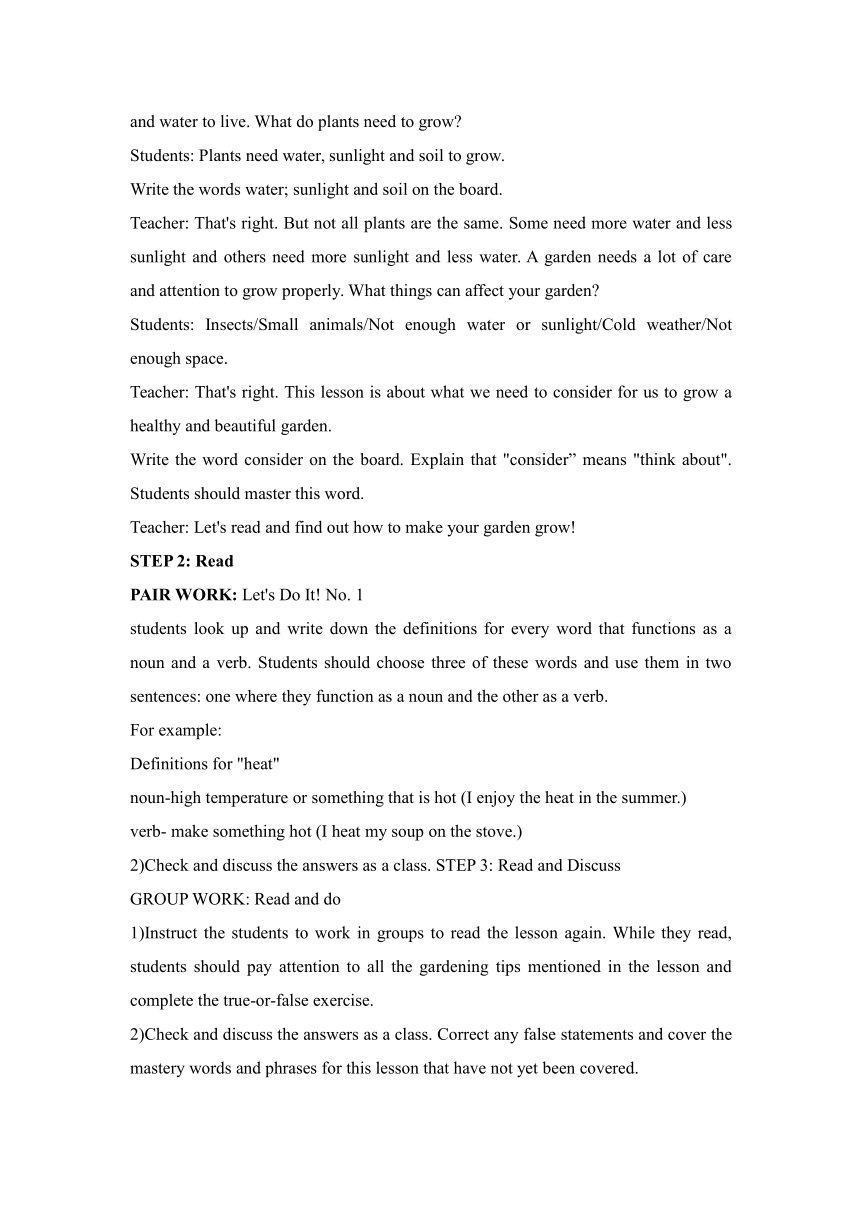Unit 2 Plant a Plant! Lesson10 教学设计 翼教版(2024)八年级下册
文档属性
| 名称 | Unit 2 Plant a Plant! Lesson10 教学设计 翼教版(2024)八年级下册 |  | |
| 格式 | docx | ||
| 文件大小 | 19.5KB | ||
| 资源类型 | 教案 | ||
| 版本资源 | 冀教版 | ||
| 科目 | 英语 | ||
| 更新时间 | 2024-12-20 16:24:34 | ||
图片预览



文档简介
Unit 2 Plant a Plant!
Lesson 10 Make Your Garden Grow!
LESSON PREPARATION
LANGUAGE KNOWLEDGE
掌握词汇: consider, test, dry, purpose
接触词汇: sunlight, compost, nearby, squirrel, fence
短语和句型: make sure, keep... away from..., best of all
RESOURCES
a list of gardening tips
research material about gardening
.plant pot.
soil.
seeds
.pitcher of water
paint
LESSON STRUCTURE
CLASS OPENING
Greeting
Greet the class.
Say: Good morning/afternoon, everyone. How was your evening Did anyone watch TV last night What did you watch What time What channel Ask several students to respond.
Review
1)Homework check.
2)Choose some students to present their"Gardening Tip".
3)Review the theme of gardening. Discuss the similarities and differences between gardening and farming.
Teacher: What is a garden
Students: A piece of land, often near a home, that is used to plant and grow flowers, fruits and vegetables.
Teacher: Are a garden and a farm the same thing / Are gardening and farming the same thing
Students: No.
Teacher: How are they the same/different
Make a list of similarities and differences between ardoning and forming on the be
Garden(ing) Garden and Farm Farm(ing)
usually smaller
than a farm both grow fruits and vegetables usually bigger than a garden
usually grow
flowers both are important don't usually grow flowers
often done as a
hobby both can be enjoyable often done as a job
don't raise
animals in a
garden both need a lot of care and
attention raise animals on a farm
KEY CONCEPTS
FOCUS STRUCTURES:
You can test it to make sure.
What else do you need to consider for your garden It can help keep these small animals away from your garden.
And best of all, you have fun eating all the great food from it.
STEP 1: Present
CLASS WORK: Think About It
Discuss the Think About It questions as a class. Teacher: Do you like gardening
Students: Yes, I like gardening. It's fun. /No, I don't like gardening. It's boring.
Teacher: What is fun about growing a garden
Students: You can enjoy spending time outdoors./ It's fun to watch your garden grow./It's nice to have your own fresh fruits and vegetables that you grew yourself./It's nice to have beautiful flowers and other plants to look at.
Teacher: Very good. All plants have basic needs just like we do. Humans need food and water to live. What do plants need to grow
Students: Plants need water, sunlight and soil to grow.
Write the words water; sunlight and soil on the board.
Teacher: That's right. But not all plants are the same. Some need more water and less sunlight and others need more sunlight and less water. A garden needs a lot of care and attention to grow properly. What things can affect your garden
Students: Insects/Small animals/Not enough water or sunlight/Cold weather/Not enough space.
Teacher: That's right. This lesson is about what we need to consider for us to grow a healthy and beautiful garden.
Write the word consider on the board. Explain that "consider” means "think about". Students should master this word.
Teacher: Let's read and find out how to make your garden grow!
STEP 2: Read
PAIR WORK: Let's Do It! No. 1
students look up and write down the definitions for every word that functions as a noun and a verb. Students should choose three of these words and use them in two sentences: one where they function as a noun and the other as a verb.
For example:
Definitions for "heat"
noun-high temperature or something that is hot (I enjoy the heat in the summer.)
verb- make something hot (I heat my soup on the stove.)
2)Check and discuss the answers as a class. STEP 3: Read and Discuss
GROUP WORK: Read and do
1)Instruct the students to work in groups to read the lesson again. While they read, students should pay attention to all the gardening tips mentioned in the lesson and complete the true-or-false exercise.
2)Check and discuss the answers as a class. Correct any false statements and cover the mastery words and phrases for this lesson that have not yet been covered.
Words Phrases
test make sure
dry keep... away from
purpose best of all
STEP 4: Activity
GROUP WORK: Read and do
1)Instruct the students to work in groups to write one gardening tip of their own. Make sure no two groups choose the same gardening tip.
** Note: You may want to provide the students with a list of gardening tips to choose from and some research materials to help them better understand the topic.
2)Encourage the students to be creative. They may choose to present their gardening tip in a variety of ways but should include clear written instructions and images (drawings or cut out pictures)to go with it.3)Ask the groups to present their gardening tip in front of the class.
Sample Gardening Tips o How to plant and grow strawberries o How to get rid of weeds
o How to grow a cherry tree
o How to keep the insects away from your garden o How to make sure your garden gets enough water
STEP 5: Task
INDEPENDENT WORK: Project
1)As a class, brainstorm some ideas for different things you can grow in a garden and why you might want to grow those things.
2)Instruct the students to work independently to write a short passage about something they'd like to plant in a garden. Students can follow the example in the student book.
3)Ask some students to read their passage in front of the class.
CLASS CLOSING
1)Complete Let's Do It! No. 3.
Students do the exercise independently, then check the answers in groups, and finally as a class.
2)Assign homework:
My Garden: Draw a plan for a garden. Draw and label each plant in the garden. Consider what plants (flowers, fruits, vegetables, trees, etc. you will have in your garden and why.
EXTENSION
PAIR/GROUP WORK: Hands On Activity
Complete the Hands On Activity to review vocabulary, phrases and concepts from this lesson.
**Note: You may want to ask the students to bring in their own supplies for this activity.
1) Divide the class into small groups or pairs and provide each group or pair with a pot, soil, seeds and a pitcher of water. Before planting the seed in the pot, you may want to give the students some time to decorate their pot.
2)Each pair or group must follow the instructions in the Hands-on Activity at the bottom of Lesson 10.
LANGUAGE NOTES
1. You must consider many things when you decide to begin gardening.在你开始进行园艺活动的时候 必须考虑很多事情。
consider在句中意为“认为”,与think about同义。 常用于以下句型:
1)consider+名词/代词/doing。例如:
You had better consider my advice.你最好考虑一 下我的建议。
I'm considering going to Dalian for my summer holiday.我正在考虑去大连度暑假。
2)consider+宾语从句/“疑问词+不定式”。例如:We must consider what we shall do next. We must consider what to do next.我们必须考虑下一步做 什么。
2. Does your garden get enough sun 你的花园有充 足的阳光吗?
sun 在句中意为“阳光”,即sunshine 或 sunlight。 例如:
Don't read in the sun. It's bad for your eyes.不要在 阳光下看书。对眼睛不好。
3. You can test it to make sure.你可以检测一下来 确定。
make sure在句中意为“确定,确信”。此外,还有“务必,保证,核实,确保”等意思,后面可跟宾语从句、动词不定式或者疑问词+动词不定式。例如:
We should look it up in the dictionary to make sure. 我们应该查查词典来确定一下。
Make sure that you brush your teeth every night. Make sure to brush your teeth every night.你一定 要每天晚上刷牙。
4. Is it easy to water your garden 给你的花园浇水 容易吗
water在句中作动词,意为“浇水,浇灌”。例如:You need to water the flowers twice a day.你需要 每天给花浇两次水。
5. Plants need water to grow strong and stay healthy. 植物需要水来长得强壮和保持健康。
grow和stay在句中均作系动词,后跟形容词,grow意为“(渐渐)变得/长得”,stay意为“保持”。例如:
All the students have grown taller.所有的学生都长 高了。
Stay (Keep)still a minute, I want to take your photograph.保持一会儿,我要给你照张相。
6. It can help keep these small animals away from your garden.它能阻止这些小动物进入你的花园。keep(.)away from.意为“使(·..)远离...” 例如:
Tell the child to keep away from the fire.告诉那个 孩子离火远点儿。
The cages can keep us away from the wild animals. 笼子能使我们远离那些野生动物。
3. You can test it to make sure.你可以检测一下来 确定。
make sure在句中意为“确定,确信”。此外,还有“务必,保证,核实,确保”等意思,后面可跟宾语从句、动词不定式或者疑问词+动词不定式。例如:
Lesson 10 Make Your Garden Grow!
LESSON PREPARATION
LANGUAGE KNOWLEDGE
掌握词汇: consider, test, dry, purpose
接触词汇: sunlight, compost, nearby, squirrel, fence
短语和句型: make sure, keep... away from..., best of all
RESOURCES
a list of gardening tips
research material about gardening
.plant pot.
soil.
seeds
.pitcher of water
paint
LESSON STRUCTURE
CLASS OPENING
Greeting
Greet the class.
Say: Good morning/afternoon, everyone. How was your evening Did anyone watch TV last night What did you watch What time What channel Ask several students to respond.
Review
1)Homework check.
2)Choose some students to present their"Gardening Tip".
3)Review the theme of gardening. Discuss the similarities and differences between gardening and farming.
Teacher: What is a garden
Students: A piece of land, often near a home, that is used to plant and grow flowers, fruits and vegetables.
Teacher: Are a garden and a farm the same thing / Are gardening and farming the same thing
Students: No.
Teacher: How are they the same/different
Make a list of similarities and differences between ardoning and forming on the be
Garden(ing) Garden and Farm Farm(ing)
usually smaller
than a farm both grow fruits and vegetables usually bigger than a garden
usually grow
flowers both are important don't usually grow flowers
often done as a
hobby both can be enjoyable often done as a job
don't raise
animals in a
garden both need a lot of care and
attention raise animals on a farm
KEY CONCEPTS
FOCUS STRUCTURES:
You can test it to make sure.
What else do you need to consider for your garden It can help keep these small animals away from your garden.
And best of all, you have fun eating all the great food from it.
STEP 1: Present
CLASS WORK: Think About It
Discuss the Think About It questions as a class. Teacher: Do you like gardening
Students: Yes, I like gardening. It's fun. /No, I don't like gardening. It's boring.
Teacher: What is fun about growing a garden
Students: You can enjoy spending time outdoors./ It's fun to watch your garden grow./It's nice to have your own fresh fruits and vegetables that you grew yourself./It's nice to have beautiful flowers and other plants to look at.
Teacher: Very good. All plants have basic needs just like we do. Humans need food and water to live. What do plants need to grow
Students: Plants need water, sunlight and soil to grow.
Write the words water; sunlight and soil on the board.
Teacher: That's right. But not all plants are the same. Some need more water and less sunlight and others need more sunlight and less water. A garden needs a lot of care and attention to grow properly. What things can affect your garden
Students: Insects/Small animals/Not enough water or sunlight/Cold weather/Not enough space.
Teacher: That's right. This lesson is about what we need to consider for us to grow a healthy and beautiful garden.
Write the word consider on the board. Explain that "consider” means "think about". Students should master this word.
Teacher: Let's read and find out how to make your garden grow!
STEP 2: Read
PAIR WORK: Let's Do It! No. 1
students look up and write down the definitions for every word that functions as a noun and a verb. Students should choose three of these words and use them in two sentences: one where they function as a noun and the other as a verb.
For example:
Definitions for "heat"
noun-high temperature or something that is hot (I enjoy the heat in the summer.)
verb- make something hot (I heat my soup on the stove.)
2)Check and discuss the answers as a class. STEP 3: Read and Discuss
GROUP WORK: Read and do
1)Instruct the students to work in groups to read the lesson again. While they read, students should pay attention to all the gardening tips mentioned in the lesson and complete the true-or-false exercise.
2)Check and discuss the answers as a class. Correct any false statements and cover the mastery words and phrases for this lesson that have not yet been covered.
Words Phrases
test make sure
dry keep... away from
purpose best of all
STEP 4: Activity
GROUP WORK: Read and do
1)Instruct the students to work in groups to write one gardening tip of their own. Make sure no two groups choose the same gardening tip.
** Note: You may want to provide the students with a list of gardening tips to choose from and some research materials to help them better understand the topic.
2)Encourage the students to be creative. They may choose to present their gardening tip in a variety of ways but should include clear written instructions and images (drawings or cut out pictures)to go with it.3)Ask the groups to present their gardening tip in front of the class.
Sample Gardening Tips o How to plant and grow strawberries o How to get rid of weeds
o How to grow a cherry tree
o How to keep the insects away from your garden o How to make sure your garden gets enough water
STEP 5: Task
INDEPENDENT WORK: Project
1)As a class, brainstorm some ideas for different things you can grow in a garden and why you might want to grow those things.
2)Instruct the students to work independently to write a short passage about something they'd like to plant in a garden. Students can follow the example in the student book.
3)Ask some students to read their passage in front of the class.
CLASS CLOSING
1)Complete Let's Do It! No. 3.
Students do the exercise independently, then check the answers in groups, and finally as a class.
2)Assign homework:
My Garden: Draw a plan for a garden. Draw and label each plant in the garden. Consider what plants (flowers, fruits, vegetables, trees, etc. you will have in your garden and why.
EXTENSION
PAIR/GROUP WORK: Hands On Activity
Complete the Hands On Activity to review vocabulary, phrases and concepts from this lesson.
**Note: You may want to ask the students to bring in their own supplies for this activity.
1) Divide the class into small groups or pairs and provide each group or pair with a pot, soil, seeds and a pitcher of water. Before planting the seed in the pot, you may want to give the students some time to decorate their pot.
2)Each pair or group must follow the instructions in the Hands-on Activity at the bottom of Lesson 10.
LANGUAGE NOTES
1. You must consider many things when you decide to begin gardening.在你开始进行园艺活动的时候 必须考虑很多事情。
consider在句中意为“认为”,与think about同义。 常用于以下句型:
1)consider+名词/代词/doing。例如:
You had better consider my advice.你最好考虑一 下我的建议。
I'm considering going to Dalian for my summer holiday.我正在考虑去大连度暑假。
2)consider+宾语从句/“疑问词+不定式”。例如:We must consider what we shall do next. We must consider what to do next.我们必须考虑下一步做 什么。
2. Does your garden get enough sun 你的花园有充 足的阳光吗?
sun 在句中意为“阳光”,即sunshine 或 sunlight。 例如:
Don't read in the sun. It's bad for your eyes.不要在 阳光下看书。对眼睛不好。
3. You can test it to make sure.你可以检测一下来 确定。
make sure在句中意为“确定,确信”。此外,还有“务必,保证,核实,确保”等意思,后面可跟宾语从句、动词不定式或者疑问词+动词不定式。例如:
We should look it up in the dictionary to make sure. 我们应该查查词典来确定一下。
Make sure that you brush your teeth every night. Make sure to brush your teeth every night.你一定 要每天晚上刷牙。
4. Is it easy to water your garden 给你的花园浇水 容易吗
water在句中作动词,意为“浇水,浇灌”。例如:You need to water the flowers twice a day.你需要 每天给花浇两次水。
5. Plants need water to grow strong and stay healthy. 植物需要水来长得强壮和保持健康。
grow和stay在句中均作系动词,后跟形容词,grow意为“(渐渐)变得/长得”,stay意为“保持”。例如:
All the students have grown taller.所有的学生都长 高了。
Stay (Keep)still a minute, I want to take your photograph.保持一会儿,我要给你照张相。
6. It can help keep these small animals away from your garden.它能阻止这些小动物进入你的花园。keep(.)away from.意为“使(·..)远离...” 例如:
Tell the child to keep away from the fire.告诉那个 孩子离火远点儿。
The cages can keep us away from the wild animals. 笼子能使我们远离那些野生动物。
3. You can test it to make sure.你可以检测一下来 确定。
make sure在句中意为“确定,确信”。此外,还有“务必,保证,核实,确保”等意思,后面可跟宾语从句、动词不定式或者疑问词+动词不定式。例如:
同课章节目录
- Unit 1 Spring Is Coming
- Lesson 1 How's the weather?
- Lesson 2 It's Getting Warmer!
- Lesson 3 Sun Is Rising
- Lesson 4 The Spring City
- Lesson 5 Babysitting on a Spring Day
- Lesson 6 Stories about Spring
- Unit 2 Plant a Plant
- Lesson 7 Planting Trees
- Lesson 8 Why Are Plants Important?
- Lesson 9 Gardening with Mary
- Lesson 10 Make Your Garden Grow!
- Lesson 11 Amazing Plants
- Lesson 12 Danny's Plant
- Unit 3 Animals Are Our Friends
- Lesson 13 Danny's Big Scare
- Lesson 14 Amazing Animals
- Lesson 15 The Zoo Is Open
- Lesson 16 The Pear Escaped
- Lesson 17 Save the Tigers
- Lesson 18 Friendship Between Animals
- Unit 4 The Internet Connects Us
- Lesson 19 How Do You Use the Internet?
- Lesson 20 A Computer Helps!
- Lesson 21 Books or Computers?
- Lesson 22 Travel on the Internet
- Lesson 23 The Internet--Good or Bad?
- Lesson 24 An E-mail to Grandpa
- Unit 5 Buying and Selling
- Lesson 25 Raising Money
- Lesson 26 Cookies, Please!
- Lesson 27 Business English
- Lesson 28 Ms. Liu's Great Idea
- Lesson 29 How to Push a Product
- Lesson 30 A Cookie Sale
- Unit 6 Be a Champion!
- Lesson 31 Don't Fall, Danny
- Lesson 32 My Favourite Record
- Lesson 33 2800 Years of Sports
- Lesson 34 Modern Olympics
- Lesson 35 The Dream Team
- Lesson 36 Classroom Olympics
- Unit 7 Know Our World
- Lesson 37 Let's Learn Geography!
- Lesson 38 The World Is a Big Place
- Lesson 39 Ring Up or Call?
- Lesson 40 Body Language
- Lesson 41 A Class of the World
- Lesson 42 North America
- Unit 8 Save Our World
- Lesson 43 Let's Clean Up!
- Lesson 44 Environment Clubs
- Lesson 45 Let's Sort Garbage!
- Lesson 46 Protect Our Environment
- Lesson 47 Connected to Nature
- Lesson 48 Garbage Is Interesting!
